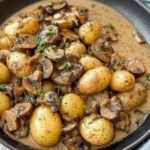Why Roasted Leg of Lamb is a Classic Favorite
The popularity of roasted leg of lamb endures for a reason. It’s the kind of dish that transforms an ordinary meal into a memorable event. The meat itself is naturally flavorful, and when prepared correctly, it develops a caramelized crust that locks in its juices. Unlike other roasts that require brining or complex marinades, this recipe leans on fresh rosemary, thyme, garlic, lemon zest, and Dijon mustard—ingredients that enhance the natural richness of the lamb without overpowering it. When roasted to perfection, the leg of lamb offers tender slices that melt in your mouth and pair effortlessly with a wide array of sides.
Perfect for Special Occasions and Holidays
This dish is particularly revered during Easter, symbolizing renewal and celebration in many traditions. However, its appeal extends beyond religious holidays. It’s a stellar option for Christmas dinners, wedding receptions, or any family reunion where the goal is to impress and satisfy a crowd. The leg of lamb is naturally large enough to serve up to eight guests, making it ideal for group meals. Its presentation—especially when roasted alongside golden baby potatoes or root vegetables—adds a rustic elegance to the dining table.
Aromatic and Flavorful Garlic-Herb Rub
One of the key features that sets this recipe apart is the deeply aromatic garlic-herb rub. Combining minced garlic with freshly chopped rosemary and thyme creates an herbaceous backbone that permeates the meat. The addition of lemon zest cuts through the richness, adding brightness and a hint of acidity, while Dijon mustard contributes a tangy depth and aids in forming a crisp crust. Olive oil binds the mixture, helping it adhere to the lamb and lock in moisture during roasting. The rub not only seasons the exterior but also seeps into the shallow cuts made across the surface of the meat, ensuring each slice is flavorful from edge to center.
Easy Yet Impressive Preparation
Despite its luxurious taste and festive appearance, this roasted leg of lamb recipe is easy enough for intermediate home cooks. After rubbing the lamb with the herb mixture, it is placed in the oven and roasted until it reaches the desired internal temperature. The most labor-intensive step is simply making the paste and rubbing it into the meat—everything else is largely hands-off. Optionally, you can toss baby potatoes or chopped root vegetables in olive oil and roast them in the same pan, letting them soak up the savory lamb juices for an effortless side dish.
Juicy, Tender Meat with a Perfect Crust
Roasting lamb correctly is a balance between developing that signature crisp crust and ensuring the inside stays moist and tender. This is achieved by roasting at a moderately high temperature and allowing the meat to rest after cooking. Resting is crucial—it allows the juices to redistribute throughout the leg rather than escaping when sliced. The result is a roast that carves beautifully and tastes as good as it looks, with every bite offering the right balance of texture and moisture.
Ideal Internal Temperatures for Roasted Lamb
To suit varying preferences, the recipe provides a clear guide to internal temperatures:
-
125°F for rare (bright red and very juicy)
-
135°F for medium-rare (rosy pink, juicy and tender)
-
145°F for medium (slightly pink center, firmer texture)
Using a meat thermometer is highly recommended to ensure your roast reaches the perfect doneness without overcooking.
A Nutrient-Rich Protein Powerhouse
Not only is this roasted leg of lamb deeply satisfying, but it also offers notable nutritional benefits. Each serving packs approximately 38 grams of high-quality protein, essential for muscle health and satiety. Lamb is also rich in important micronutrients such as iron, zinc, and vitamin B12—nutrients that support immune function, energy production, and red blood cell formation. Although it is higher in fat than some other protein options, most of the fat is trimmed during carving, and the flavorful crust makes a little fat go a long way.
Versatile Pairings and Serving Ideas
This dish pairs beautifully with a wide range of sides and sauces. Classic pairings include:
-
Roasted root vegetables such as carrots, parsnips, or turnips
-
Creamy mashed potatoes or a garlicky cauliflower purée
-
Gravy made from the pan drippings or a red wine reduction
-
Mint jelly or tzatziki for a fresh, cooling contrast
Adding a green vegetable like sautéed green beans or asparagus can also balance out the richness of the lamb.
Cooking Tips for the Best Results
For the best outcome, follow these tips:
-
Always let the meat rest at room temperature for about 30 minutes before roasting.
-
Use a sharp knife to score the surface lightly—this allows the rub to penetrate more deeply.
-
Don’t skip the resting period after roasting, as it makes a big difference in tenderness.
-
Invest in a reliable meat thermometer to avoid overcooking.
Variations to Try
This recipe is flexible and can be adapted in several delicious ways:
-
Mediterranean-style: Add crushed olives and sun-dried tomatoes to the rub for a more intense flavor.
-
Spicy twist: Incorporate a teaspoon of harissa or chili flakes into the paste for a bit of heat.
-
Honey mustard glaze: Add a tablespoon of honey to the mustard rub for a sweet-savory crust.
-
Bone-in vs boneless: While this recipe uses a bone-in leg for more flavor, boneless cuts can be used for quicker cooking and easier slicing.
Conclusion
Roasted leg of lamb is a dish that embodies tradition, celebration, and culinary simplicity at its finest. It’s a show-stopping entrée that doesn’t demand expert-level skills, making it a go-to recipe for both holidays and special dinners throughout the year. The combination of garlic, herbs, mustard, and lemon creates a fragrant crust, while the slow roasting ensures the meat is melt-in-your-mouth tender. Whether served with classic roasted vegetables or more modern sides, this dish always leaves a lasting impression. With its rich flavor, elegant presentation, and nutritional benefits, roasted leg of lamb deserves a place at your next festive gathering—or whenever you want to turn an ordinary meal into something extraordinary.






